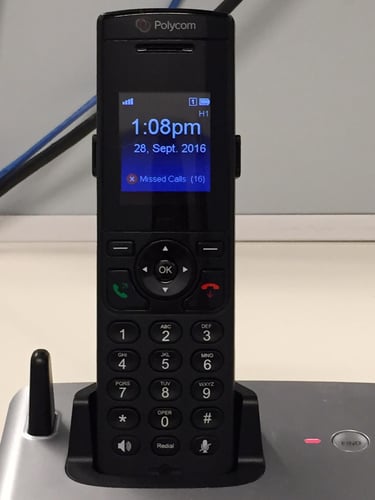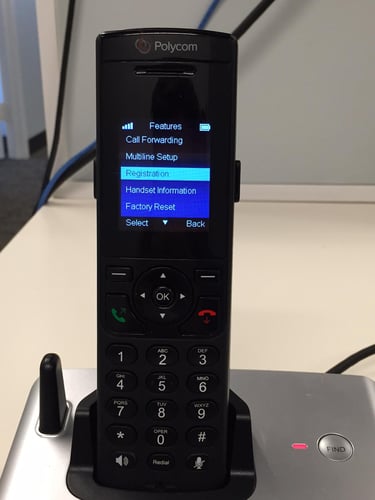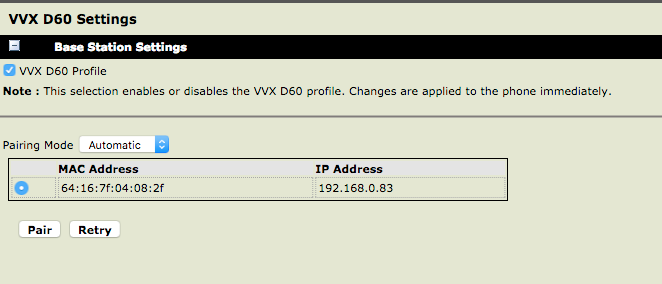Summary
| Overall: |      |
| Configuration: |      |
| OnSIP Testing: |      |
| Voice Quality: |      |
| Ease of Use: |      |
Quick Specs
- Support for pairing up to 5 DECT handsets (for VVX 300, 400, 500 and 600)
- 10/100 POE Base Station with pass-through
- 10 hours talk time, 100 hours standby
- Support for 4 simultaneous calls
Pros
- Great battery life
- High sound quality
- Loud speakerphone
Cons
- Requires VVX unit to work
- Expensive
- Slow handset interface
The Polycom VVX D60 is Polycom’s first DECT phone for the VVX series. In Polycom's words, the VVX D60 "leverages previous IT infrastructure investments" to work. In our words, this is a phone that needs another phone to operate. Specifically, the VVX D60 requires a VVX, 3XX, 4XX, 5XX or 6XX Polycom phone to function.
The Polycom VVX D60’s appeal rests with its workplace mobility. For small business employees, retail workers, or administrative personnel on the go, the VVX D60 has the potential to offer more physical flexibility than the typical desk phone. The phone also appeals to people who want to cut the cord in their office.
The Polycom VVX D60 sounds like it can help workers who want to move with freedom. But is the device, which requires another phone to run, worth the investment? We took the VVX D60 for a test drive to find out.
First Impressions

The Polycom VVX D60 works by setting up a secure connection between the D60 base unit and the host VVX (i.e., the other Polycom phone). This process actually offloads the brunt of the technical work to the host VVX phone. In other words, the D60 doesn't place calls on it own; rather, it harnesses the phone service of the host VVX to make and take calls.
To get the Polycom VVX D60 up and running, you need to plug the base station of the Polycom VVX D60 into the same network as the host VVX. The setup process is very simple but not without a few hitches. Although the D60 is reliant upon a host VVX to function, it's best if you treat the DECT unit as a whole other device. You don't want to use your host VVX's primary Line 1 account with the DECT unit. That way, you can easily switch between phones without confusion.
The D60’s hand unit feels very solid and well crafted, if a tad heavier than you might expect. The battery life boasts 10 hours of talktime and 100 hours of standby time, so it's no surprise that the included power pack is pretty heavy. The D60’s handset buttons have a good feel to them, and you can quickly learn to navigate the face of the phone just by touching it.
Features

We found the phone calls on the Polycom VVX D60 to be rock solid. Calls on the D60 were as clear and reliable as those made on the host VVX. We did find that there's a slight delay between when you push on the phone and when the information actually appears on the screen. We did not encounter a scenario where calls on the D60 lagged because of the interchange it had with the host VVX.
The VVX D60 comes with a 2-inch TFT(178x220) color display with an LCD backlight. The phone can support up to four simultaneous calls, pairing with up to five DECT handsets, and HD voice. The D60 has a range of 50 meters (165 ft) indoors and 300 meters (980 ft) outdoors. With a 10/100 POE Base Station, the D60 is wall mountable and comes with a belt clip.
The D60 doesn't support more involved features such as paging or BLF. We also experienced some odd design decisions. The D60 cannot differentiate between a Line 1 account residing on the host VVX and a Line 1 account on the D60, which disrupts functionality on both devices. The best way around this quirk is to register a second line on the host VVX that's exclusively paired with the D60.
Cost
Pricing is certainly an issue. The D60 itself costs $200. This does not include the cost of the host VVX you've either already paid for or bought specifically for the D60. If you’re locked into a Polycom environment, the D60 might be a smart purchase. But if you don't have a host VVX, it makes little sense to purchase two phones just so that you can use one of them.
Video & Sound Quality
Sound quality for the Polycom VVX D60 is very good. We had no issues hearing other callers and had no complaints from the other end when we asked about how we sounded. The speakerphone on the D60 is surprisingly loud and clear.
You can harness the D60 on the included belt clip, walk around the office, and still be heard by the person with whom you're talking. This actually caught us off guard because we were expecting a weaker pickup from a DECT phone. Polycom, as usual, has delivered exceptional sound quality with the D60.
Compatibility Testing
At OnSIP, we put each of the phones we use through a multi-step interoperability test in which we apply ~30 test cases. Here’s an example of a test case:
Test phone calls phone B
B picks up
B puts test phone on hold
B calls phone C
C picks up
B transfers test phone to C
Call must be transferred correctly to C. B must be released correctly after the transfer. When C picks up, audio must work in both ways between test phone and C. When test phone is on hold, there is no audio between it and phone B.
The Polycom VVX D60 passed all compatibility testing.
Setup
Step 1: Connect Polycom VVX D60 Base Station to network.
The physical setup is quick and simple. Connect the D60 base station to the network as outlined in the User Guide, and log into the web interface for your host VVX phone. Go to Settings -> VVX D60.

Step 2: Pair Polycom VVX D60 Base Station to host VVX.
Select the checkbox to enable the VVX D60 Profile and select your pairing method from the drop-down menu. We selected PC Port because it was the easiest for our testing purposes. Check the User Guide for information on Automatic and Manual Pairing. Hit the pair button, which should open up the handset settings.

Step 3: Register Polycom VVX D60 Base Station.
Hit Register to find your handset. We found that the Registration section is actually under Settings -> Features -> Registration on the handset.

Step 4: Map lines (as needed).
If you have two lines registered, the host VVX will shuffle the second line over to the D60 Base Station. This means that calls to the second line will not ring on the host VVX at all; in fact, the host VVX will not even show that the line exists.
If you have multiple lines and multiple handsets, you can hit the Map Lines link on the Registration page to route lines appropriately.

Once the base station is registered to the host VVX and the handset registered to the base station, you’re ready to make calls as needed.
Final Thoughts
The Polycom VVX D60 combines Polycom's high standards with exceptional mobility. The voice quality is great, the features list is fine, and the speakerphone is impressively loud. However, we would only recommend this phone to you if you already have a Polycom VVX series phone. Without a VVX phone, it makes little sense to purchase this device, given that you need two devices to get the phone up and running.
If you don't already have a Polycom VVX, 3XX, 4XX, 5XX or 6XX, you may want to look into a solid DECT device for less money, such as the Grandstream DP750, the Yealink W56P, or the Panasonic TGP600 phone.

